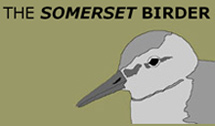Weekly round-up: 05 - 11 Mar 2014
Ahhhh, Spring.
A most welcome guest that has snuck its way in, slowly, through winter’s damp and dreary back door ~ rather gently at first ~ to proclaim itself a veritable meteorological saviour and lifter of spirits as the Jet Stream drifted north and finally lost its stormy, grey grip on much of our weather, allowing (sssssh, whisper it, ever so softly) sunshine and lovely early March warming temperatures to embrace us with the deftest of blue-skied caresses.
High pressure eased in, cold air was forced north and the temperatures climbed almost daily to well above the seasonal norm by the end of the weekend, gently nuzzling the neck of almost 20 degrees C. Whilst needing to be wary of a wintery sting-in-the-tail, for the moment at least, all was good, tho’ the onset of a brisk and all-together more expected easterly wind on North Sea coasts meant that hats and gloves couldn’t quite be left on the shelf just yet.
That’s the weather then…and now, to confession time….
This could, easily, be the closest to “winging it” that the RBA review has seen during a three-year existence. Far removed from the news and all the “goss”, this week’s review takes a hefty punt (albeit a reasonably well informed one) at the birding week just gone with little real grasp of what’s what ~ but arguably that’s never stopped birders in the past has it? Or the present for that matter…
Gazing out from the windows of a rain-splashed tram at the (always-deserted) Pomona station ~ on the watery border between Salford and Manchester ~ the delightful avian apparition of two splendid peach-bosomed Goosanders was a personal highlight this week whilst, countrywide, rares remained stacked high in rows of feathery joy ~ rows worthy of the most enthusiastic supermarket Easter Egg display (get ‘em quick kids, only seven weeks to go….)…
…and, increasingly for many, the bird that piqued the most interested (and continued to generate the most heat) was the squat Ardeola in Kent.
Many years ago, Monty Python’s “Contractual Obligation” album featured an amusing Eric Idle ditty going by the name of “I Like Chinese” and this week an increasing number of insurance listers were going down a very similar route in their affection to travellers from “the Orient” as the (presumed non adult, most likely a first-winter) Chinese Pond Heron continued to intrigue, infuriate and, ultimately, oblige many of those who bothered to head along to try their luck in the Saltwood area of Hythe, in southeast Kent.
The identification seems to be unquestionable now and so the Chinese Pond Heron has taken on more and more importance over the past couple or three weeks as more and more people have felt almost contractually obliged as a listing birder to take a chance on connecting with this elusive beastie.
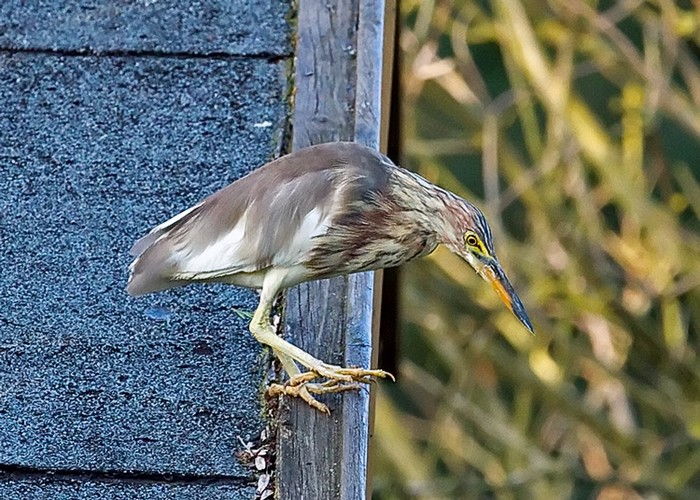
Numerous tales of woe have been documented online, the multi-visiting dippers are hopefully sated now as between 5th-8th the bird often obliged anyone in the area, showing in trees, fields, ponds and the shed roof to prove it wasn’t so awkward as some had been led to believe.
Then, as Saturday drew to a close, a flyover near the children’s playground late in the afternoon suddenly became the last bit of news ~ not a sniff of anything (positive or negative) came forth on Sunday (it turns out people were looking but the favoured spot was now “out of bounds”) and Monday was a blank for news too. Has it moved on as the first rays of spring made the bird’s migratory instincts kick in and it wondered about plotting a way back east?
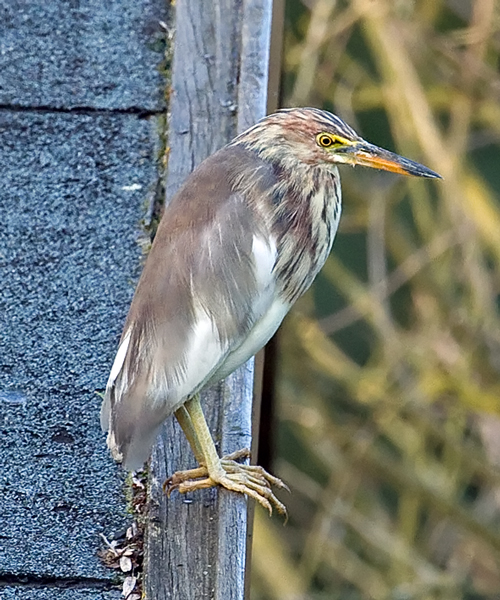
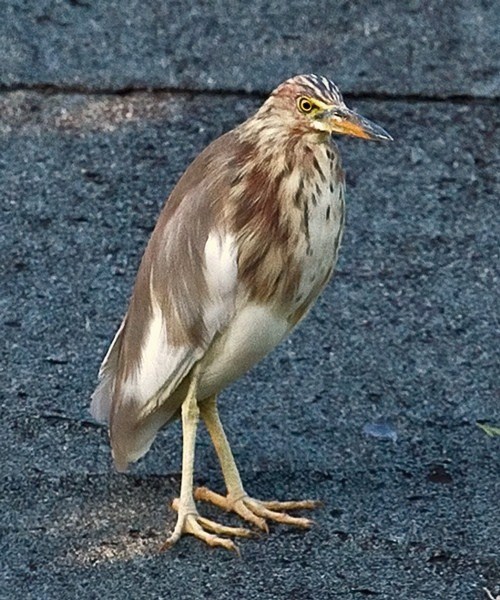
…or was it just that all interested parties had done their thing and it would only be a passing local (resident or birder or both) that would register the presence of this teasing potential add-on to the British List?
It still feels as though there’s a mountain to climb for this Category E species, more records of accepted vagrants from around the Western Palearctic would perhaps help the cause to ascent to greater things for this particular Ardeola but there’s more of a “feel-good” factor around this one than the previous Norfolk and Hampshire bird (bolstered of course by the fact that the Saltwood bird has been clocked by more than a handful of invited guests and householders).
Potential rare herons aside, all of the week’s other headline acts were all familiar faces from recent weeks and all were to be found in Scotland.
At Loch Flemington, in Highland, the American Coot did the business through to 11th, whilst heading in to month three of its stay (odds are that it may depart around early April, though if it has any amorous intentions towards the locals, well their could be allsorts of fun and games if there’s a Highland Fling in the offing…
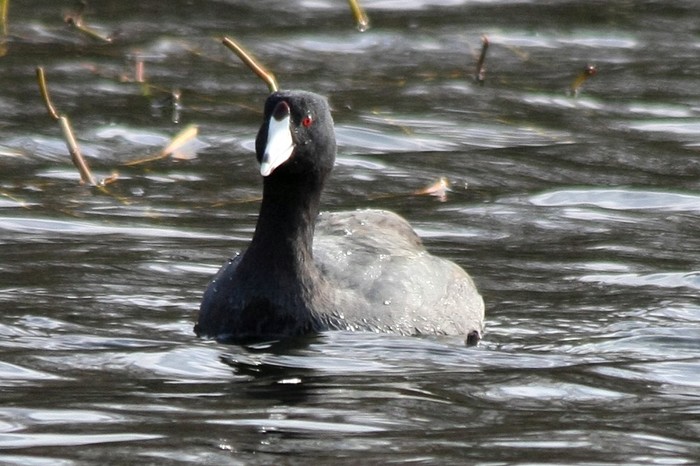
Across on the always lovely Outer Hebrides, the Pied-billed Grebe was still finding the lochs of the Balranald RSPB Reserve to be a most suitable winter and early spring location, also noted to 11th, while the bird that most seemed to take not of was the superb first-winter American Herring Gull that remained (albeit sometimes elusive) around the Campbeltown area of Argyll to 11th, drawing quite a few admirers north in the process (220 and counting).
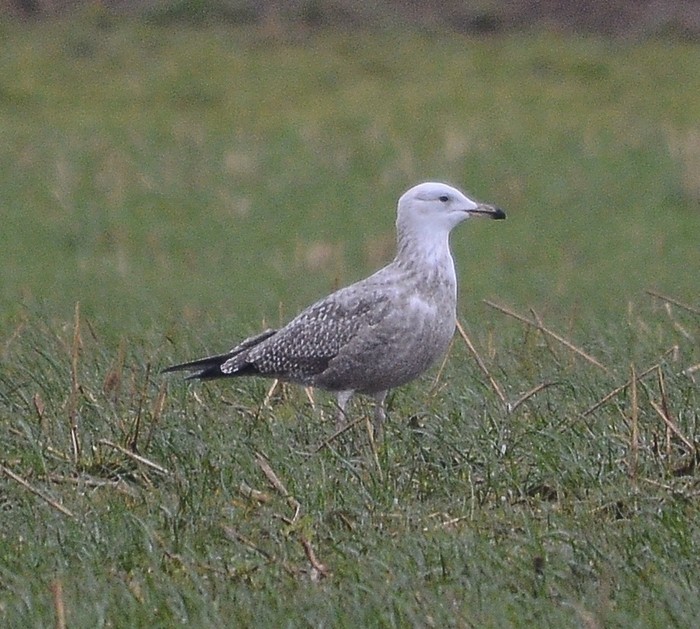
A couple of other Smickers were noted elsewhere this week ~ the presumed first-winter was still on the Mullet, at Barnatra, on 5th while a second-winter (still a brave call here) was noted at Portmagee (Co. Kerry) on 9th.
Whilst we’re taking a wander down Rare Gull Road, there was a little bit of belated news from Islay to report where last week’s juvenile Thayer’s Gull, seen at Bruichladdich on 4th may actually have been on the island for a few days prior to that ~ what may have been the same bird was also seen at Gartbreck on February 27th. Handily enough this fascinating-looking individual was then re-found, back at Bruichladdich during the afternoon of 11th. It won’t draw much of a crowd, but with Argyll at the heart of much of the week’s news, there’s a decent few days birding to be had if you’ve time to venture that way…
Finally to the borderline between Gloucestershire and Wiltshire where it seems as though the perky and rather charismatic first-winter male Red-flanked Bluetail may have taken his leave from the Marshfield area as the window of departure was left ajar overnight on 9th.
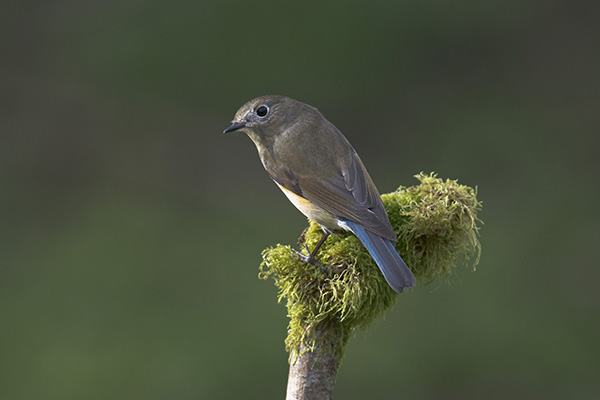
One of the draws of the second-winter period, this unique wintering individual has lit up many of grim day and some cracking shots have been achieved to document his stay. What route his departure from the UK is anyone’s guess, but early spring birds have been noted in the recent past on the English east coast and there’s every reason to think that we may be on for another one any day now.
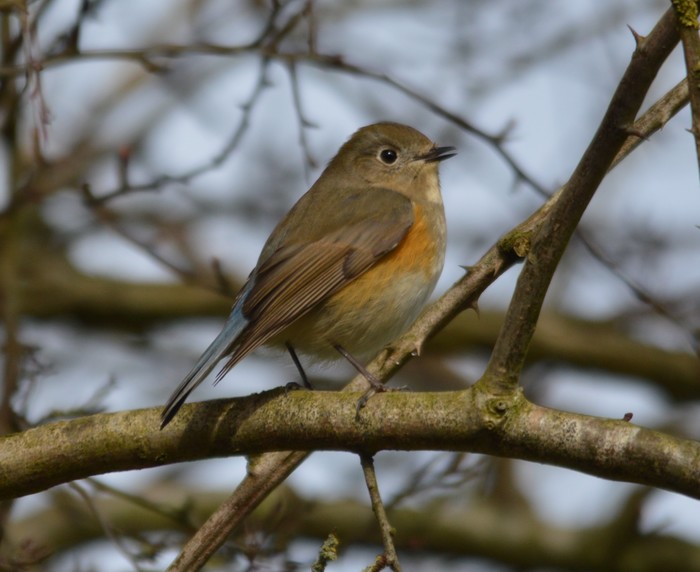
Last week’s review touched upon the potential arrivals that could wend their way towards us and, right on cue, one of them actually did make it! Late on the final day of the week it may have been, but the discovery of a first-summer Great Spotted Cuckoo in Pembrokeshire was perhaps the most exciting news of the past seven days.
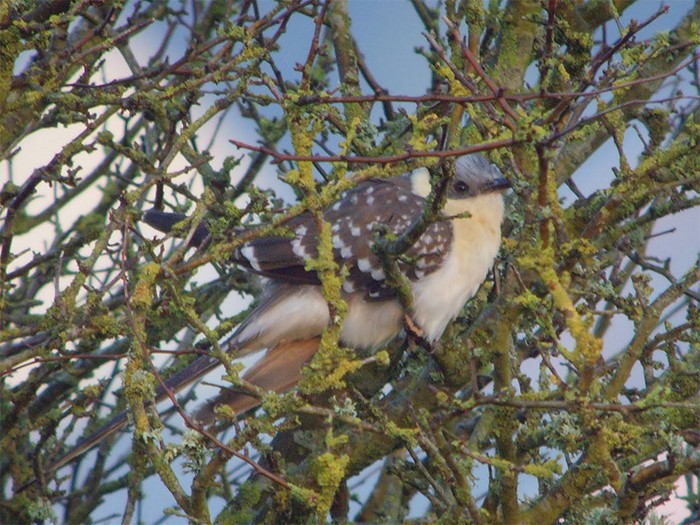
This becomes only the second record for the west Wales county ~ a county that continually seems to be scoring great birds (as touched upon in an autumn review last year) ~ the first, seen on March 10th 2009 at Trefeiddon Moor and this week’s individual pushes the number of March Great Spotted Cuckoos up to an impressive 14 (from an accepted total of 56 in all).
The first-ever March record came from Galway in 1842 and it was over 120 years ‘til the next one, in 1963 on the Isle of Man. There were two March records though the 80’s (dead in Dublin in 1983, alive in Dorset ~ like the Pembs bird found on March 11th ~ in 1989) and two came along in March 1990 (the well-twitched bird at Dawlish Warren with another at Sandwich Bay).
Another “March 11th” find came on St. Martin’s (Scilly) in 1993 and the final 90’s record came from east Norfolk late in the month in 1999. Five March Great Spotted Cuckoos were discovered during the 00’s (two in 2001 and 2009, with another in 2007 ~ two in Kent and two in Cornwall along with that first for Pembrokeshire). Interestingly there are also three accepted British and Irish February records too ~ the earliest being the bird seen at Ringaskiddy in County Cork on February 15th 2009.
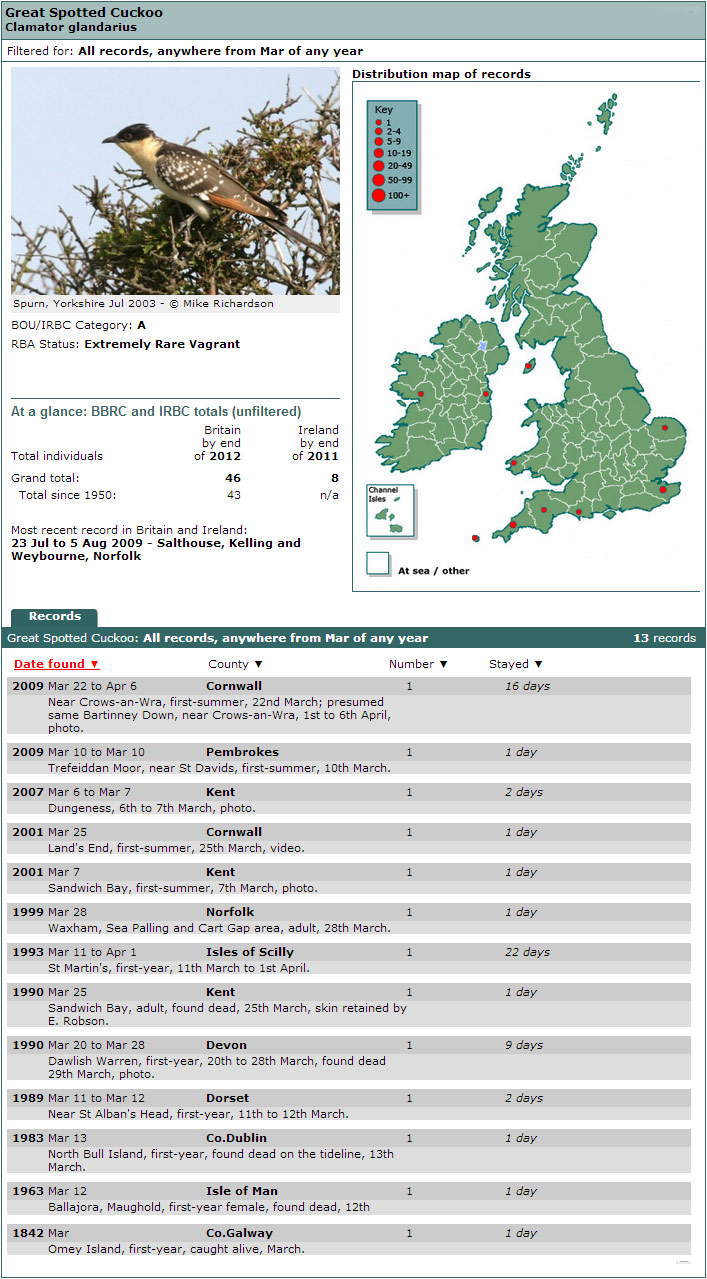
The annual White-billed Diver festival is drawing closer by the day but for now there are just two regulars to report ~ one was off Belmont, Unst (Shetland) on 7th while on Orkney, at St Margaret’s Hope off South Ronaldsay, the usual adult was present to 8th.
As with last week, there was very little else to report in Seabird World, aside from a single Little Auk off Falmouth (Cornwall) on 9th and a Pomarine Skua that headed past Ram Head (Co. Waterford) on 10th.
In a familiar north to south sweep, we’ll try and mop up the week’s Glossy Ibis with some haste….
North Ronaldsay held on to their singleton through the week while on the Mainland, at Kinross (Perth & Kinross) one was noted between 6th-9th ~ a massive county bird, only the second-ever there, the first coming in September 1903.
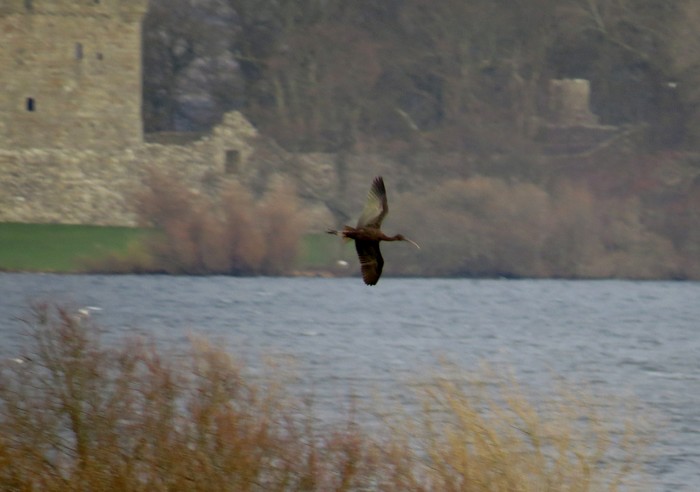
Drifting below the Wall, in Nottinghamshire a Glossy Ibis remained at Lowdham to 11th and in Norfolk it seems reasonable to think that perhaps maybe just one bird accounted for the records from Martham on 5th, Cantley RSPB on 6th and Breydon Water RSPB on 7th. Next door in Suffolk, the long-staying single was at Oulton, Lowestoft to 9th. A flock of three birds was noted heading southwest over Sharnbrook (Bedfordshire) on 6th with the same trio reported the following day near Tongwell (Buckinghamshire). Elsewhere in the southeast, two birds remained at Bognor Regis (West Sussex) to 5th, one was at Adgestone (Isle of Wight) on 9th and in Kent there were singles at Dungeness through the week and at Stodmarsh on 8th-9th. Southwestern England was represented by a single bird at Curry Moor (Somerset) on 9th-10th.
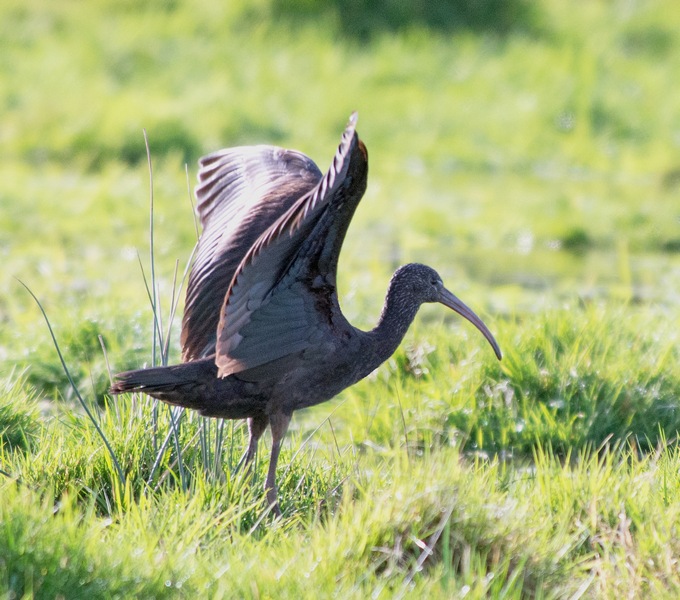
In Ireland, four Glossy Ibis were seen in three counties ~ two remained at Ballincar (Co. Sligo) to 9th and lone birds were recorded in Cork (at Timoleague on 5th) and in Kerry (near the Luane Estuary), also on 9th.
There was a slight nudge up for Great White Egrets this week, 26 birds reported from 17 counties, most of them singles.
The only multiples were logged at Westhay Moor (Somerset), three there on 9th, Dungeness and Grain Marsh (Kent) with two at the former on 5th and two at the latter on 9th, Earls Barton GPs (Northamptonshire) on 8th-10th, Stiffkey (Norfolk) on 11th and at Llanrhidian Marsh (Glamorgan) on 7th. Two more singles were also logged in Wales, at Llandeilo (Carmarthenshire) and Llangorse Lake (Powys), both on 9th.
Singles were seen at Loch Davan (Aberdeenshire) on 6th, along the Pocklington Canal (East Yorkshire) on 6th-9th, at Southport (Lancashire) and Frodsham (Cheshire) across 9th-10th. In the Midlands, along with regulars in Northamptonshire, a new single was recorded at Mountsoreel (Leicestershire) and Long Eaton (Derbyshire) on 7th while two singles were in Norfolk ~ still at Admiralty Point, near King’s Lynn, on 7th-9th and between Salthouse and Cley on 9th-10th.
The southeast saw singles in East Sussex, at Scotney and passing over Splash Point, near Seaford while in Hampshire, one was noted at Lymington on 8th. The final bird of the week was the near-resident bird at Coate Water Park (Wiltshire), present to 9th.
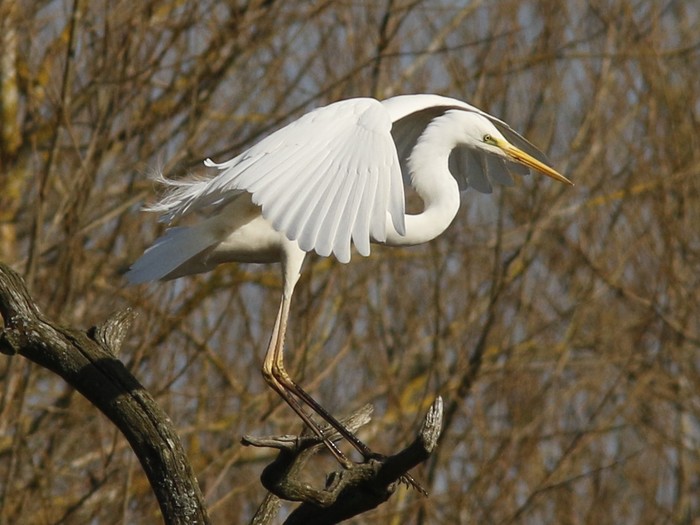
As well as a few moving Ibis and Egrets, there were a few Spoonbills to add to the list labelled “spring migrants” ~ singles in Devon, Somerset, Hampshire, Gwent and Suffolk all perhaps in that category, with the same applying to the three birds at Holkham NNR and the single at Cley NWT (Norfolk) on 8th and the two seen heading by Selsey Bill (West Sussex) on 9th.
The Dorset flock peaked at 24 birds at Shipstal Point, Arne RSPB on 5th, with 22 still around on 9th, with three more at Lodmoor RSPB at the start of the week. Another wintering trio were still at Isley Marsh RSPB (Devon) on the weekend. Singles elsewhere remained in East Sussex, Essex, Lincolnshire, Down and Kerry.
Common Cranes began to see the sap beginning to rise as the sun shone warmly across the weekend, a few birds from who-knows-where taking to air for an early drift around.
On the east coast, two birds that were seen at the tail end of last week in Lincolnshire remained around the county to 7th at least (with perhaps the same two noted again on 9th). Also during the week, on 9th, two Cranes headed over Buckton (East Yorkshire) and Filey Bay (North Yorkshire) with the same two continuing to track north over Seahouses (Northumberland) on 10th. The same date also saw three birds circling over Grantham (Lincolnshire), a trio that were also seen in Nottinghamshire earlier in the day, at Langford Lowfields RSPB.
On the north Norfolk a single bird was at Holkham, then Cley and Salthouse on 9th with three over Strumpshaw Fen RSPB the same day (could they have been heading to Notts.?). Up to seven remained in Broadland while one was noted in Cambridgeshire, at Wicken Fen NT on 9th with two there on 11th and half a dozen or so around Eldernell the same day.
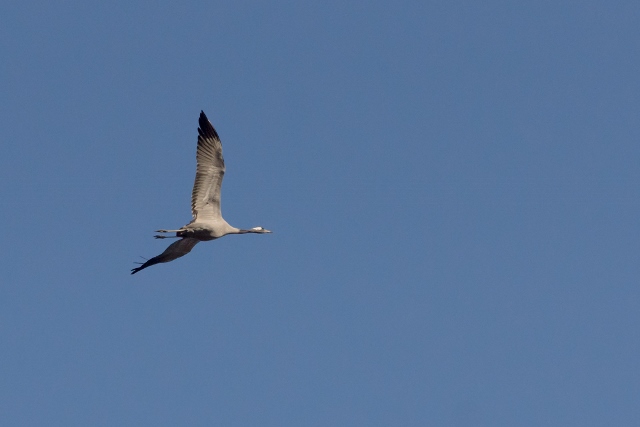
Dorset’s double remained Cheselbourne to 9th and a single Crane was seen heading north at Elton Hall Flash (Cheshire) on 10th.
…and before moving on, here’s a species that’s possibly never going to see the light of day here again but is worthy of a mention ~ Red Grouse ~ one of which got locals at Flamborough Head in to all sorts of a tizz this week ~ the first for the recording area and only the second for East Yorkshire (following one at Spurn in 1938).
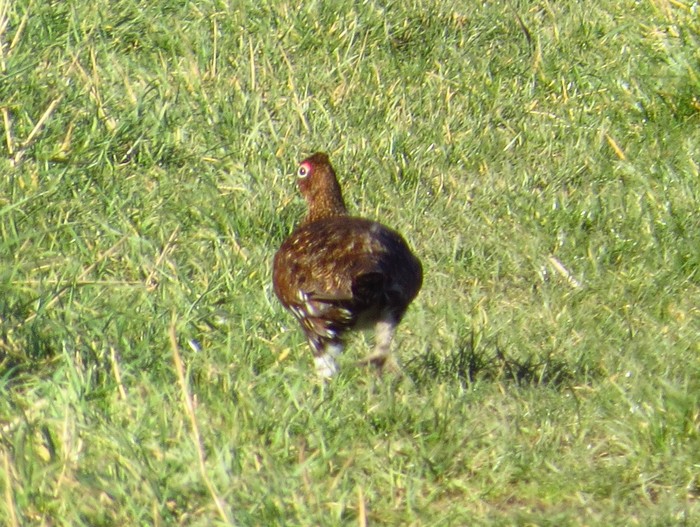
One or two Richardson’s Cackling Geese remained on Islay through the week (seen at Loch Indaal and Loch Skerrols) while Sligo’s goose fields held on to another “Hutch”, at Ballyconnell, to 10th, while some of those taking in the Campbeltown American Herring Gull were also able to take in the Campbeltown Todd’s Canada Goose to 5th.
Also a draw for Smiths Twitchers were the pair of wintering Snow Geese at Tayinloan, still present to 10th. Others this week were one at Muthill (Perth & Kinross) on 5th and twos for Muck (Highland) on 10th and at Rattray Head (Aberdeenshire) throughout the week.
The latest review began with the adult Black Brant still in situ at Roa Island (Cumbria) and was followed by one at Castlegregory (Co. Kerry) on 6th, Dawlish Warren (Devon) and Farlington Marsh (Hampshire) on 7th, on the Great Ouse and on Cley NWT (Norfolk) on 8th while the first-winter was at Kilnsea (East Yorkshire) to 9th. While there’s never an issue with a Brant, there’s been a few issues with Red-breasted Goose of late, and the appearance of an unringed bird around Southerness Point and Loaningfoot (Dumfries & Galloway) on 11th is a curio ~ a recent bird there (only a few days ago) was deemed an escape but this one, with no ring, may well be a returning bird, seen here in at least 2012 and 2013.
A garden pond is more the domain of a funny (potentially plastic) little heron rather than a popular quacker, but the drake Black Duck at Strontian seems to be rather taken by the pond in the garden at #19 Anaheilt ~ seen there on 7th and 10th.
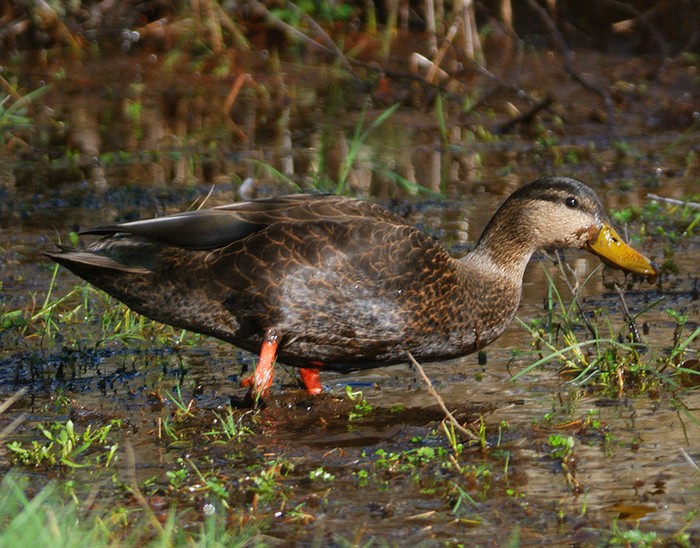
Green-winged Teals nudged in to double figures this week ~ 11 or 12 on offer ~ most of them “old-timers”. New were single drakes at Jarrow (Co. Durham) from 5th-10th, near Scarborough (North Yorkshire) on 7th-8th and Holy Island (Northumberland) on 8th (with it or another then at Howdon Wetland NR on 11th) and at Dungeness RSPB (Kent) on 11th. Others remained on North Ronaldsay (Orkney), at Caerlaverock (Dumfries & Galloway), Mossblown (Ayrshire), Saltholme RSPB (Cleveland), Christchurch Harbour (Dorset) and on Lough Swilly (Co. Donegal) throughout various points of the past seven days.
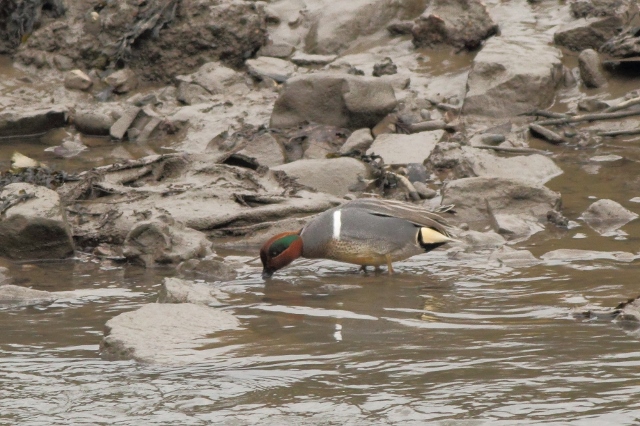
There were just two single drake Lesser Scaups reported this week as the winter gradually faded to very early spring ~ in Cornwall one remained on Dozmary Pool to 9th and in Staffordshire, the popular bird at Tittesworth Reservoir was present to 10th at least. There were barely anymore Ring-necked Ducks to play with either, just four of those noted ~ Irish drakes seen at Lough Swilly on 6th, Tullyratty Dam (Co. Down) on 9th and Ross Castle, Killarney (Co. Kerry) on 11th, while the female was ever-present on Loch Scaraidh, North Uist (Outer Hebrides) to 11th. In Hampshire the drake Ferruginous Duck was at Blashford Lakes to 5th.
As with last week there were three American Wigeons to report ~ Scottish drakes were still at in Udale Bay (Highland) and at Loch Borinish, South Uist (Outer Hebrides) ~ to 7th and 9th respectively ~ while Ireland saw a drake linger at Reedy Flats, Lough Neagh (Co. Antrim), also to 9th.
Off Scotland’s east coast, female King Eiders remained at Ruddon’s Point (Fife) and Yellow Craig CP (Lothian) through most of the week, while Ireland’s double bill of old queens remained at Blacksod (Co. Mayo) and Cahermore (Co. Cork) to 9th.
Pensarn continued to score the impressive numbers of Surf Scoters this week ~ six the highest count of the week on 9th (five of them drakes). Elsewhere it was singles all round ~ the young drake was still in Cornwall’s Mount’s Bay at the start of the week as was an adult drake in Fife’s Largo Bay. The juvenile was again in Poole Harbour (Dorset) on 6th when another adult drake was noted in Scotland, at Musselburgh (Lothian). The 7th saw a drake appear in County Clare, seen from Coolsiva Quay and the 9th saw singles for Courtmacsherry (Co. Cork) and Llandulas (Conwy).
Hampshire kept hold it both the Long-billed Dowitcher and Lesser Yellowlegs for a while longer ~ the former still at Keyhaven Marshes to 10th, the latter remaining at Lepe CP to 11th.
Also still lingering for a while longer, the extraordinary wintering Marsh Sandpiper on North Uist ~ seen at Loch nam Feithean on 9th-10th. More expected, if still a tad early, was the Kentish Plover that was reported at Rye Harbour NR (East Sussex) on 5th.
The ever-delectable adult Ross’s Gull popped up again in Cork’s Kinsale Harbour on 9th while Argyll muscled in with another great bird, in the shape of an adult Bonaparte’s Gull that contiuned to hang out at Ormsary (a stone’s throw, on a good day, from Loch Caolisport where it was last week) until 11th. A second Scottish Bony’s remained around Scrabster (Highland), also to 11th while in Wales, in Cardiff, the adult was again at the Heliport on 9th. Back in Highland, on Canna, the adult Franklin’s Gull was ever-present to 10th.
Ireland’s 14 Ring-billed Gulls were spread through eight counties with two singles in Wicklow, two together at Tralee Wetlands (Co. Kerry) on 6th, three singles across County Cork and three together at Nimmo’s Pier (Co. Galway) on 7th (including the only young bird registered this week).
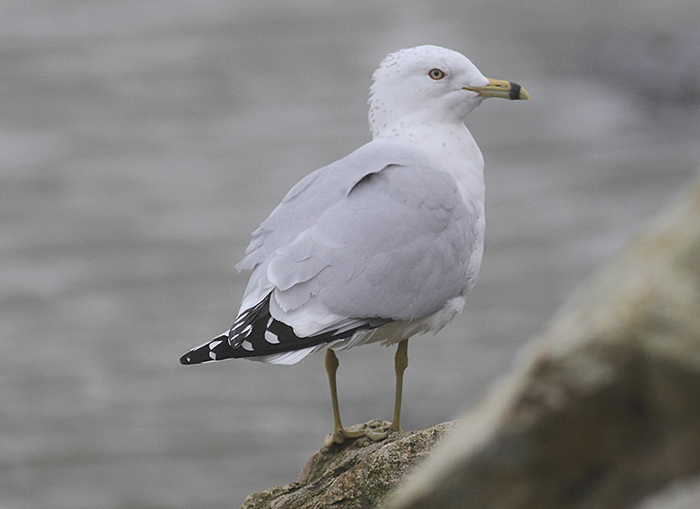
At Newburgh, in Fife, the adult Ring-billed Gull spent the week along the River Tay while the adult at Gosport (Hampshire) lingered to 10th. In Wales, at Blackpill Beach (Glamorgan) ~ home of course to Britain’s first-ever record of the species in March 1973) ~ two adults were seen on low tide on 8th with another adult at Loughor (also in Glamorgan) on 11th.
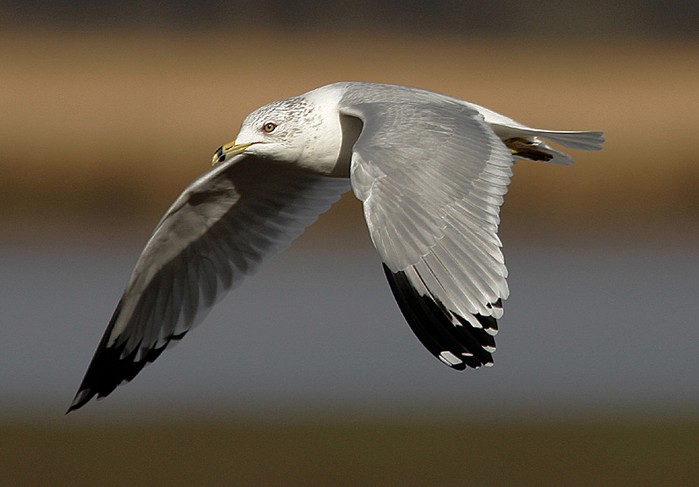
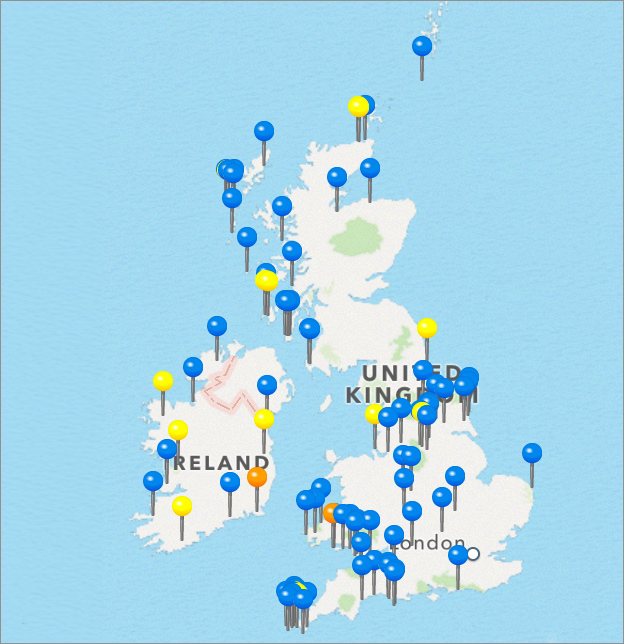
2014 has been a strong gull year already and arguably the run of Thayer’s Gulls and also Kumlien’s Gull has been one of the undoubted features (and highlights) for many folk.
This week was no exception, around 34 birds noted across Britain and Ireland (mainly the latter) ~ with a total of 24 juveniles in that overall tally. Leading the way, typically, was Killybegs where at least eight birds were logged on 8th (four juveniles and four second-winters) while a juvenile, a third-winter and an adult were at Balranald RSPB on North Uist on 6th. Up to four birds were seen in Galway, including two juveniles at Ballynahown on 8th while non-juveniles included a second-winter at Loch Ryan (Dumfries & Galloway) on 8th and single adults at Anglers’ Country Park (West Yorkshire) on 5th and on the Ogmore Estuary (Glamorgan) on 11th. The spread of birds elsewhere was certainly far and wide ~ from Fair Isle to the Lizard with the striking juvenile at Littlehampton still remaining quite a draw…
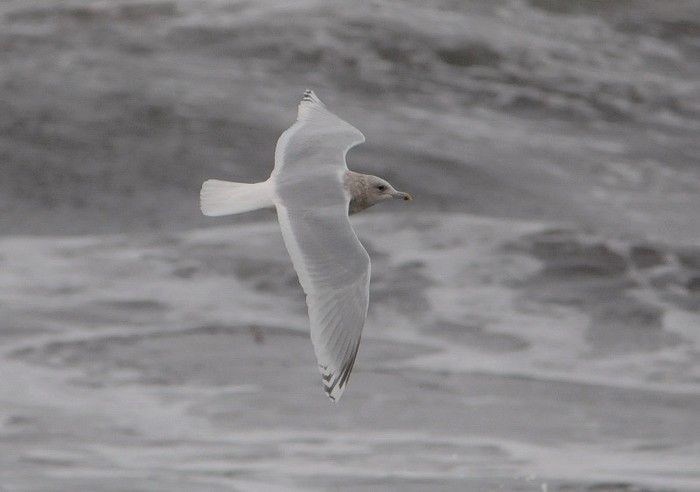
Iceland Gulls split themselves with 69 birds across 33 British counties while Ireland managed 28 birds in 12 counties. Galway’s Ballynahown lead the way with six birds on 7th with Killybegs one behind with five on 8th. Up to 10 birds were recorded around the Outer Hebrides, including four at Stornoway, Lewis, on 10th with four each for this week’s Patagonia Rest Stop hotspot of Campbeltown (Argyll) on 5th when a further quarter were also seen at Cheshire’s Richmond Bank. Dorset and Cornwall held a minimum four a piece, as did East Yorkshire but for the rest of us, it was only ones or twos (if you were lucky).

Numbers of Glaucous Gullsfor Britain stalled just below the 75 mark this week ~ with up to 31 noted around Scotland, a total which included 10 at Balranald RSPB North Uist on 6th (with a further five on the same island on the same day). Argyll scored at least five, Shetland four and Moray three. Next came the southwest, with Cornwall registering upwards of 10 through the week, including four in the Mount’s Bay roost on 8th while three birds at West Bexington (Dorset) on 9th is also certainly of note too. Up to nine birds were logged in Wales, while other regions saw numbers fall to six (in the southeast), three (in the Midlands and the northeast) with two for East Anglia (both on the water at Grafham on 5th).
After 160-odd last week, Irish Glaucous Gull figures fell to just over 50 birds this week ~ with the eight birds recorded near Wexford’s Carnsore Point on 9th the highest individual figure noted (a minimum 11 were in the county as a whole). Maybe as many as 14 were seen in Cork, including six at Cahermore, also on 9th, with nine for Kerry (including five around Dingle at the start of the week), five for Louth and four for Donegal, all at Killybegs on 8th.
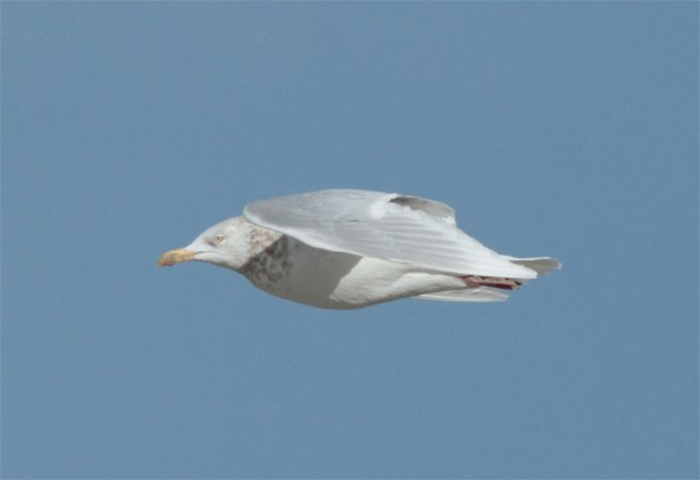
A potential first-winter grey Gyr Falcon was photographed at Read’s Island, in the north end of Lincolnshire on 10th, having been seen there initially the previous day. Luckily for those searching hard for the bird as the week drew to a close the bird was back on what seems to be a favoured log during the afternoon of 11th.
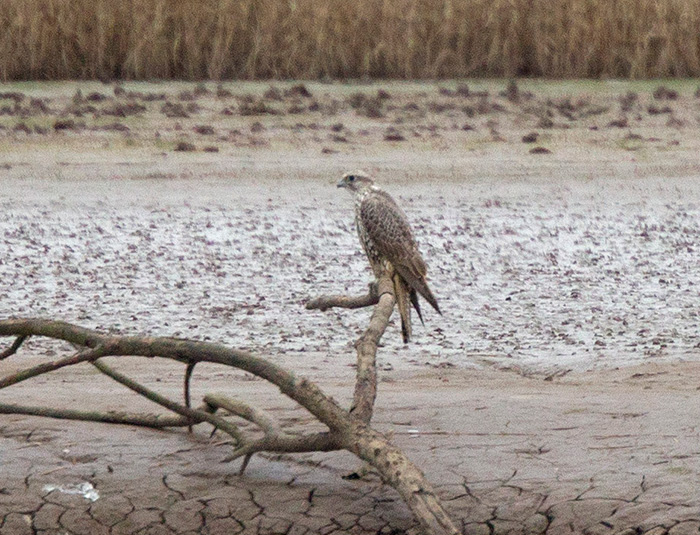
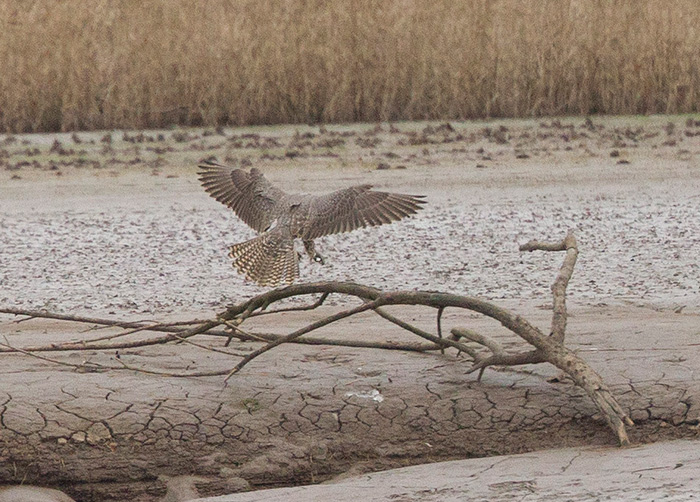
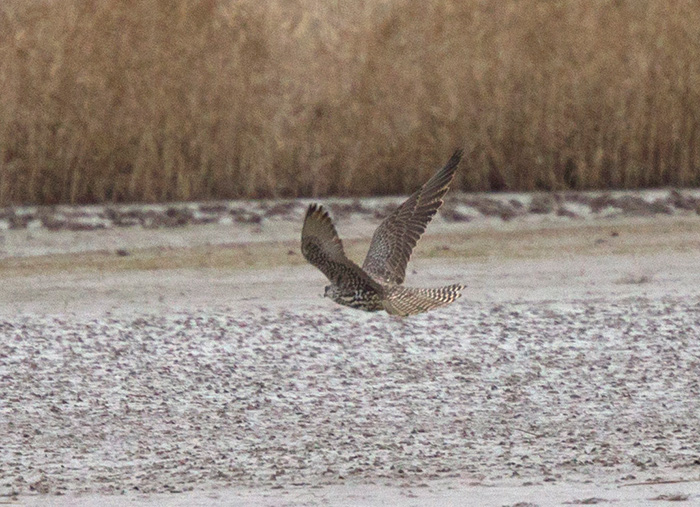
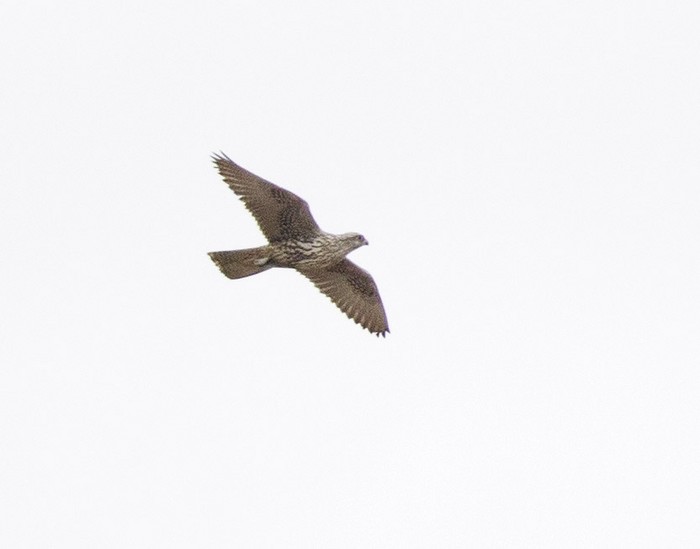
Graham Catley’s more than useful images throw up allsorts of conundrums ~ not least as to exactly what the bird may actually be ~ a hybrid has been mentioned already now that the excellent photos are out there (Saker X Gyr an option, but it is definitely unringed and bears no jesses) with others opting for a young Saker or, indeed, a young Gyr.
Falcon ID is a notorious area to wander in to due (almost entirely) to escaped hybrids and multiple crosses and back-crosses and this bird is a real teaser ~ and one best left to the full-on falcon intelgensia. There’s no doubting just how striking and impressive it is and it may well be the very same bird seen in East Yorkshire, at Patrington Haven, in late November 2013 and the same indiviudal now appears to have been seen at Far Ings (also in Lincolnshire) on February 16th.
As with last week, if you anted to see a Rough-legged Buzzard you had to head to Norfolk ~ the solitary domain for the species again this week. Singles lingered around the Ongar Hill area and the woods and dunes at Holkham and Burnham Overy, while across the other side of the county, around the Waveney Forest and Haddiscoe Marshes area, two birds remained to 9th.
There really is nothing quite like that little hop, skip and jump in the heart when you’re out in the field and catch the first jaunty, expectant and hopeful notes of your first singing Chiffchaff of the year ~ and that was just one of the common migrants that appeared as the sun shone and year-lists were dusted down a little more during the week.
Local bird news channels began to register the first Wheatears, the occasional Swallow, a few House Martins and a small pulse of Sand Martins along with a scattering of migrant Black Redstarts too ~ truly, spring migration is one of Evolution’s very finest natural events…

Maps generated using our smartphone app BirdAlert PRO
Make your records count this spring
With so many of us making particular note of our first spring arrivals it is great opportunity to use the BTO's superb Birdtrack to log your sighthings. If you don't already use then head on over to the website and download the excellent Smartphone app and make sure your records count.
…and as well as these delightful common birds wending their way to our shores after another mind-boggling journey, we were also treated to the news of six flippety-floppety overshooting Hoopoes as the week came to a close ~ four of them appeared on 10th, at Porthgwarra (Cornwall), on Lundy (Devon), around the short sward of Snodland (Kent) and also briefly at Ballycotton (Co. Cork). The following day saw another couple of birds arrive in the far southwest, on St. Mary’s (Scilly) and at Polgigga (Cornwall). Far less expected, though equally as welcome was the remarkable record of a Wryneck at St. Brides (Pembrokeshire) on 9th and again on 11th. It’s a race to the record books to see if we’ve had an earlier one…but it was nice to see that the bird was found by Peter and Rosemary Royle, of Orphean Warbler fame…
Encouraging signs, but they were the only notable new spring birds this week (give ‘em chance, we’re only just in to week two of March…), so it was back to over-wintering bits and bobs to see us to the end of another week and another round-up.
All three wintering Hume’s Yellow-browed Warblers remained on station for a few more days this week ~ the Ramsgate cemetery bird was still around to 9th, Warwickshire’s first-ever Hume’s lingered at Hams Hall to 10th and the Dungeness trapping area still hosted bird three to 11th.
In Worcestershire at the start of the week, a Yellow-browed Warbler was still to be seen at Uffmoor Wood, while Somerset’s single at Bruton was also present on the same day, with the 5th also seeing two singles still in Cornwall ~ at the sewage works at Ponsanooth and Gwennap while the fifth bird logged on the 5th was seen in gardens at Topsham (Devon). Bird six of the week was found on 7th on Studland (Dorset) with number seven (Cornwall’s third) was still at Torpoint on the same day with the eighth making a brief appearance in Bournemouth on 10th.
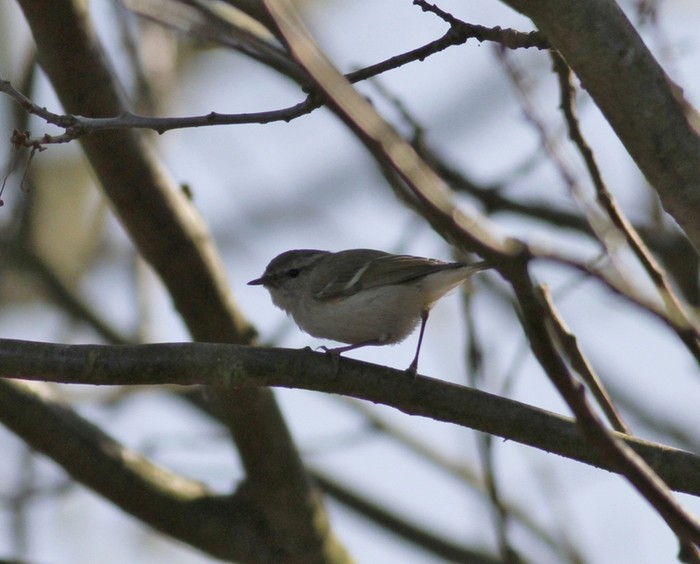
Possible or probable blythi Siberian Lesser Whitethroats lingered at Tynemouth (Northumberland), Retford (Nottinghamshire), Egginton (Derbyshire) and again in Northamptonshire to various points of the week ~ all this Sylvia malarkey isn’t everyone’s cup of tea (we can’t have such crackers as the Redcar ”Desert” Lesser Whitethroat ~ a lovely minula folks! ~ so what do we gain from seeing birds like these that look just like birds we were call the self-same thing 25 years ago? Full circle, with added DNA I guess. I’ll take gulls all day long…
Back in the southwest, the Richard’s Pipit found last week at Wall Common (Somerset) was in place on 5th but not afterwards while another was seen at Keyhaven Marshes (Hampshire) on 9th and along the coast in Kent, a single Penduline Tit remained at Dungeness RSPB to 9th.
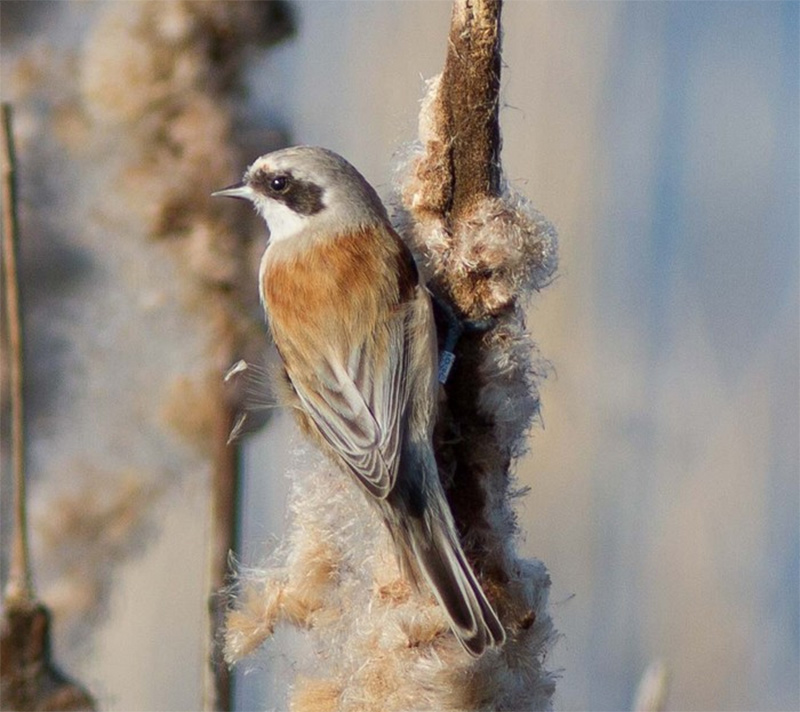
A dozen Great Grey Shrikes were seen on the first day of the new review period (5th) ~ with three still in Hampshire (at Kingclere, Fritham and Bransbury Common), two in Gloucestershire (both in the Forest of Dean, at Staple-edge Wood and near Cinderford), with singles in Somerset (at Nether Stowey), Dorset (in the Wareham Forest), Worcestershire (at Lower Bittell Reservoir), in Gwent (in the Wentwood Forest), in Surrey (on Thursley Common) in Debighshire (at World’s End) and in North Yorkshire (at the Langdale Forest).
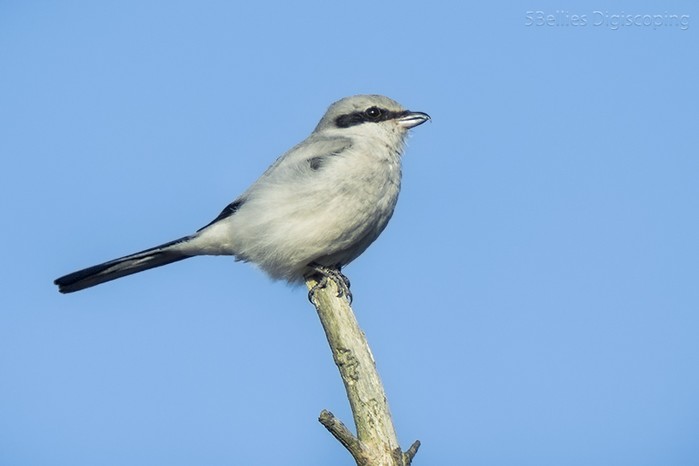
Adding to the list were singles still at Holme Fen (Cambridgeshire), Ibsley Common (Hampshire), Woorgreens NR (Gloucestershire) and Dalby Forest (North Yorkshire) all on 7th, with more logged in Hampshire (up to three more New Forest sites), Dorset and Gloucestershire (another for the Forest of Dean) across the weekend, along with birds at Exford, on Exmoor (Somerset), on Dartmoor, at Soussons Down and in Wales at Cross Inn Forest (Ceredigion) and Twmbarlwm (Glamorgan) while on 10th, a Great Grey Shrike at Woking (Surrey) took the tally close to 25 birds.

Parrot Crossbills were becoming more and more thin on the ground, with numbers falling away at the only site for the species this week ~ seven or eight remaining at Edgefield, near Holt (Norfolk) to 11th ~ how many have left and how many have begun to start the breeding process is up for discussion, but there’s been oodles of song heard of late. Who knows where it’ll all lead.
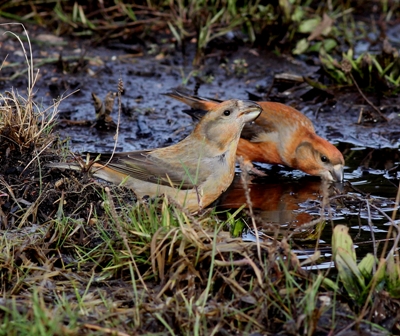
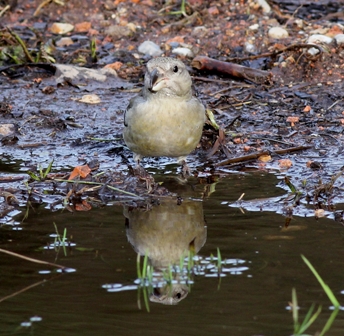
In Gloucestershire, at least nine Two-barred Crossbills remained along the Serridge Ridge to 6th with six still around the larches at Broomhead Reservoir (South Yorkshire) to 9th. Elsewhere, the first-winter male was still at Broughton (Lincolnshire) on 9th with the same date seeing the male pop up again in the Hemsted Forest (Kent). Back in the Forest of Dean, a pair of TBXB’s were seen at Woorgreens Lake NR on 10th and at least two were still at Button Oak (Shropshire) on the same day while the lone young male remained at Lynford Arboretum (Norfolk). Also on 10th, a new male was found at Farnham Heath RSPB (Surrey) where it stayed to 11th.
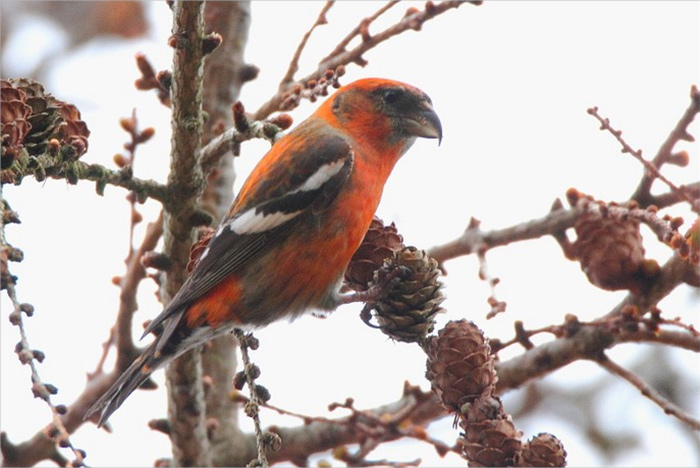
Two-barred Crossbill UK 3 from Lewis Thomson on Vimeo.
Two-barred Crossbill calls recorded in Forest of Dean, Gloucestershire. (© Lewis Thompson)
The grand total of Waxwings countrywide this week was 58 (or so) and included at least 30 at Inverkeilor (Angus) on 5th with a dozen elsewhere in the same county, at Forfar, also on 5th.
The weather appears to be at the mercy of a sizeable ridge of high pressure for the next few days ~ offering up an inviting corridor for another little wave of early, early migrants though winds appear to be light and variable, but there’s enough about things to perhaps yield a little south coast surprise maybe….
Two or three options, classic options were touched on last week, one of them we know came to be bang on ~ but the other two, Alpine Swift and Sardinian Warbler could still be in the frame if prevailing conditions come our way and if we had some warm southerlies, an early rare heron, Woodchat Shrike or even Pallid Swift could also be “ones to watch for”.
Maybe a rare crake will oblige ~ both Little and Baillon’s have occured in the second to third weeks of March ~ there are actually 17 Littles accepted for the month, the most recent ones being the popualr, well-twitched birds at Bough Beech in 1997 and Cuckmere Haven in 1985, while Baillon’s has just one, from Hampshire in 1990 (so you can see where the smart money should go)...
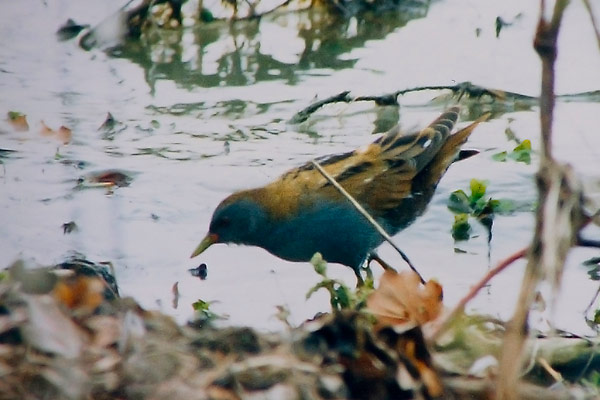
But maybe we shouldn’t aim so high? Maybe the sheer wonderment of some of those common migrants edging their way to us is more than enough to be going on with. Rest easy for a while and see what comes along eh?
Mark Golley
12 March 2014
Many thanks to this week's contributors for their photos and videos














